How should we preserve the vast amount of anime original drawings and videos to pass them on to future generations? TRIGGER director talks about “2D animation material archive!”

Anime's original drawings, storyboards, and setting material collections are necessary materials for making an anime, but they are no longer used once the anime is completed. Up until now, these animation production materials had been discarded after some time had passed, but there are voices saying that they should be preserved for various reasons.
About the 2D animation material archive! Machi★Asobi vol.27: Event information - Anime Hack
https://anime.eiga.com/event/162818/
Kazuya Masumoto, who has been in the anime industry for 23 years since 2000, started out as a production manager rather than a creator, then became an animation producer, and currently serves as the director of TRIGGER's production and director of TRIGGER. .
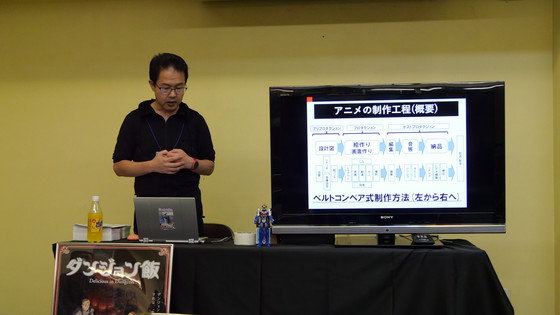
◆What is “intermediate product”?
Anime is produced using a conveyor belt style, where the production process proceeds in the order of blueprints (pre-production), drawings (production), editing, sound, and delivery (post-production).
During the animation production process, materials called ``intermediate products'' are generated, such as original drawings and setting materials, which are no longer needed once the animation is completed. TRIGGER, which was founded in 2011, will be celebrating its 13th year in 2023, and it was decided within TRIGGER that it should archive its intermediate products as materials. Mr. Masumoto was appointed as the person in charge of this archive project, and it seems that it has entered its third year at the time of writing this article.
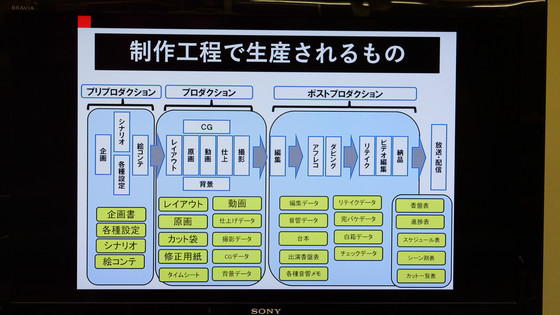
This time, as examples of various intermediate products, reproduced original drawings, setting material collections, and storyboards were displayed in cut bags, and visitors were able to pick them up and view them as they liked. .

For example, a TV anime that lasts 30 minutes per episode requires 270 kg of paper materials alone. Including the cut bags and everything else, one title is expected to weigh more than 1 ton. A studio that can produce 8 titles at the same time would generate 8 tons of waste, and it costs money to store that amount, so it ends up being discarded.
In recent years, there has been an academic movement to study anime as a culture. However, even if anime intermediate products are donated to museums or universities, it is unclear whether they will be preserved as valuable. In the first place, as to whether intermediate products of animation such as original drawings and setting material collections have any value, from the standpoint of preserving them, it is better that they have no value. This is because when something has value, it becomes an asset and taxes are generated.
Regarding intermediate products, it is said that the contract requires that the production company store them for 2 to 4 years. However, after that, it is basically discarded and treated as industrial waste. Basically, intermediate products are owned by the production committee or the client, and permission is required from the owner whether they are to be disposed of or stored. However, since it costs money to preserve it, they generally do not refuse to throw it away. In other words, the current situation is that it is judged that there is no need to preserve it, or rather that it is impossible.
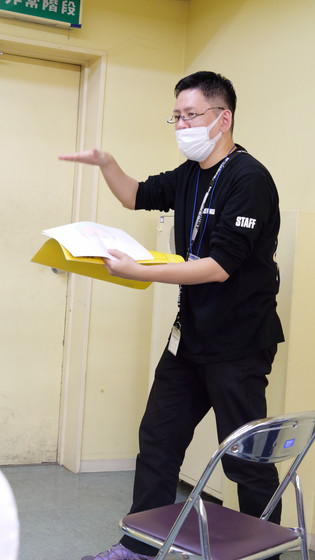
TRIGGER only produces about one title a year, and the number of works is relatively small, and TRIGGER seems to have kept almost all the intermediate products of the works he has produced so far, and stored them in a warehouse in Saitama. . These materials are stored in clear cases, and it is said that the amount of material is equivalent to 40 cardboard boxes for 12 episodes of one season of TV animation. Furthermore, archiving differs from mere preservation in that it is necessary to assume access to the materials, so we must also carefully consider the preservation method, including where and in what condition even a single piece of paper should be preserved.
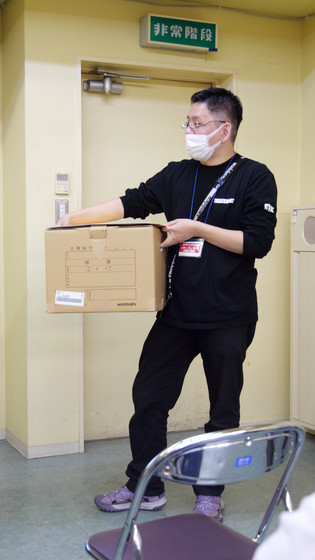
In addition, it seems that it is about 20 to 30 TB when converted to data, and when it is converted into data, it is all stored on the HDD, but since the HDD has a limited lifespan, it is still costly to store when considering HDD replacement and data transfer. It is said that it will take a while.
◆Purpose and meaning of archiving intermediate products
When I thought about why I needed to archive with TRIGGER, I thought it would be better to archive, and the purpose became the issue. Archives are a means, not an end.
Not because ``anime is a wonderful industry'' or ``because it's valuable,'' but unless we find a reason to do it several years in the future, we won't have the motivation to continue the archive business. TRIGGER needs to find meaning in archiving its own materials.
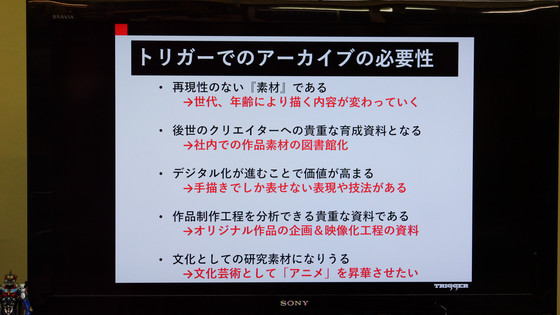
Original drawings, videos, and storyboards are personal products. As creators grow, the pictures they drew in the past are different from the pictures they draw now. Because the content drawn by creators changes depending on generation and age, intermediate products can be said to be materials that cannot be reproduced. In addition, past animation materials are valuable materials that can be used to analyze the production process later, so it makes sense to archive past animation materials.
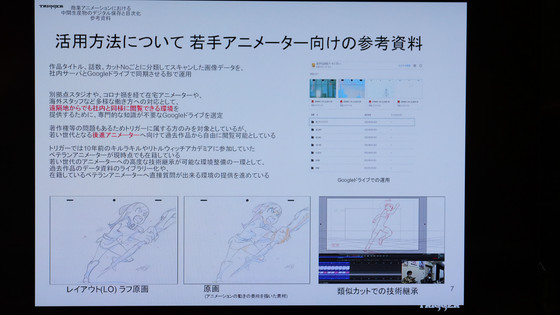
Also, there is a person on TRIGGER who says, ``I entered the anime industry after watching ``Kill la Kill.'' Mr. Masumoto's idea is that if there are no past materials left for such people, they will end up with nothing but admiration. Therefore, TRIGGER's archive has a strong meaning of ``in-house document viewing room.''

Anime production sites are becoming increasingly digital, and young creators are said to be working almost 100% on LCD tablets. However, since there are expressions and techniques that can only be expressed by hand-drawing, Mr. Masumoto believes that hand-drawn animation will never disappear. It is hoped that the materials will be turned into a viewing room.
In addition, past anime materials can be used as cultural research materials. In fact, TRIGGER has received requests for materials from domestic and foreign laboratories. His research activities included automatic generation of animation videos and coloring, and patterning of illustration compositions (layouts). There was also a request from an American university to study
TRIGGER's ``Little Witch Academia'' was released in March 2013 as a 25-minute theatrical animation as part of the Agency for Cultural Affairs' ``Anime Mirai 2013'', a project to foster young animators. This 'Little Witch Academia' material data is provided to the National Institute of Informatics (NII) as a 'trigger data set.'
Storyboards, etc. of the anime “Little Witch Academia” will be used for research - Animation work material data produced by TRIGGER will be provided to academic researchers - National Institute of Informatics
https://www.nii.ac.jp/news/release/2022/0315.html
◆Archiving work details
Archiving plans can be divided into three parts: ``work scanning,'' ``table of contents,'' and ``pre-production material scanning.''
Archiving doesn't just mean storing things in a warehouse; you also have to think about how to preserve them. For example, large-format original drawings made from multiple sheets of paper are subject to rapid deterioration due to the use of cellophane tape. Paper may also be folded during storage, which can also cause deterioration. Furthermore, piling up large amounts of paper can also lead to deterioration, making it impossible to store anime materials permanently due to the physical quantity. Even the orientation when storing paper materials in a cardboard box must be considered.
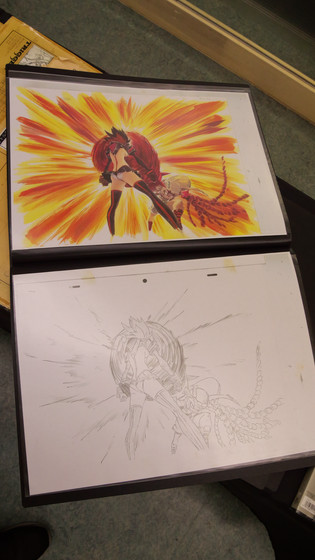
Therefore, when archiving data, it is simply impossible to store large amounts of paper materials as they are, and it is necessary to convert them into data. When it comes to data storage, resolution and format are important, and according to Mr. Masumoto, the best resolution for converting intermediate products into data is 800 dpi, which is designed to withstand publication printing. However, since the amount of data becomes huge, TRIGGER saves it at 400 dpi. Also, it seems that the format is HEIF format.
The work is scanned at an average speed of 40 cuts per day with two scanners in operation. Since one episode of a typical TV series has about 300 cuts, it is expected that scanning of one episode will be completed in about 8 days, and if it is 12 episodes in one season, it will be completed in about 100 days.

To archive, data must be organized into a table of contents. The important thing when archiving data is ``Where is it stored and who will use it?'' You need to be able to tell who drew the cut, what title it was, and when it was drawn.
Below are cut bags that hold various intermediate products such as original drawing materials, layout materials, video materials, etc.
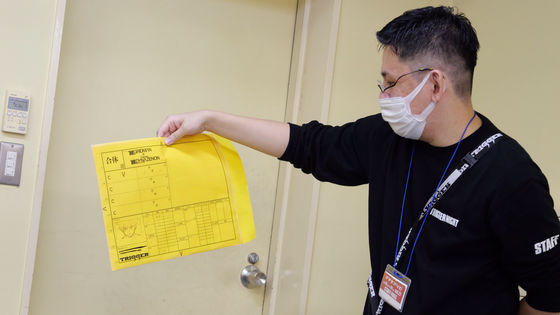
The cut bag has information such as the title, number of episodes, cut number, length, scene thumbnail, number of cels, and the name of the person in charge. This information can be used as metadata for the material.
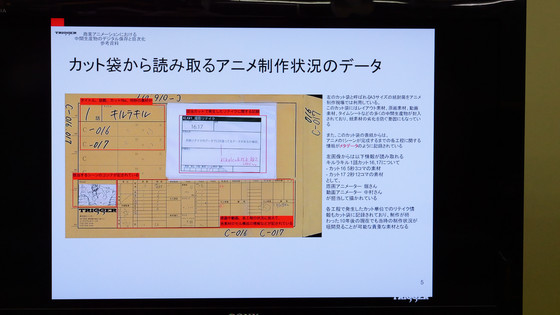
According to Mr. Masumoto, the most important intermediate products are the recording table, progress table, schedule table, scene table, and cut list that are generated in post-production. These records include the name of the person in charge of cutting, the date of delivery, the cut number, and the quantity, which is said to be extremely important as metadata for archiving. However, it seems that these materials including metadata have not been preserved until now.
In the future, it is predicted that the name of the creator will be the trigger for young people to research materials in the archives. It would also be desirable to be able to search based on the content of the picture, such as ``hair flowing'' or ``slow walking.'' However, the challenge is that such tagging requires a much larger amount of work.
And when it comes to archiving, they want to be able to view it anytime and anywhere. Especially in recent years, as digitalization has progressed and it has become possible to work from home, it is desirable to be able to view materials anywhere without location restrictions. TRIGGER is said to be creating a prototype using Google's system, but at the time of writing the article, it seems that problems with convenience and speed are being resolved.
This kind of archiving work is also done by anime production companies other than TRIGGER. Production IG has been working on it for 10 years, and Sunrise (currently Bandai Namco Film Works) is also trying to archive past works. Studio Color has a close relationship with the Anime Special Effects Archives Corporation (ATAC), and is said to have one of the best records in the industry in terms of archive business.
In addition, as anime production progresses to digitalization, standardization of metadata and archive files is required, but it is difficult to do so because the media and formats to save them change with the times. According to the person in charge of TRIGGER's systems, there are few engineers in the anime industry, and there is not much movement to create uniform standards like industry standards.
Regarding storage media, Mr. Masumoto introduced an episode from ``Tengen Toppa Gurren Lagann''. When it was decided to reprint this film, which was originally a film package, to DCP (Digital Cinema Package), it was discovered that the audio data was lost. When I looked into it at random, I was told that it was found on magnetic disk ZIP media. However, because the drive that was found had not been powered for decades, it was said that the data might be lost, so they took it to a specialized company and were able to extract the acoustic data. As a lesson from this time, Mr. Masumoto seems to have learned, ``Let's save it properly, and make sure to have a media player.''
Related Posts:







